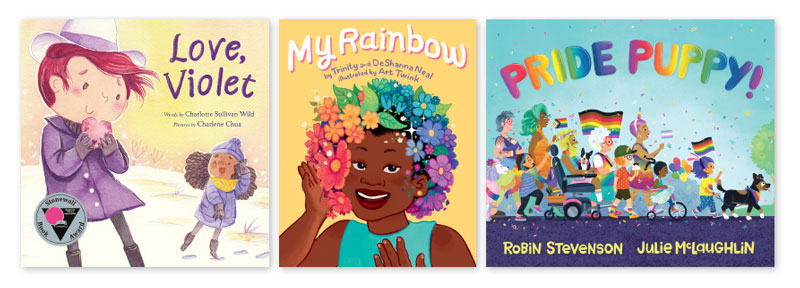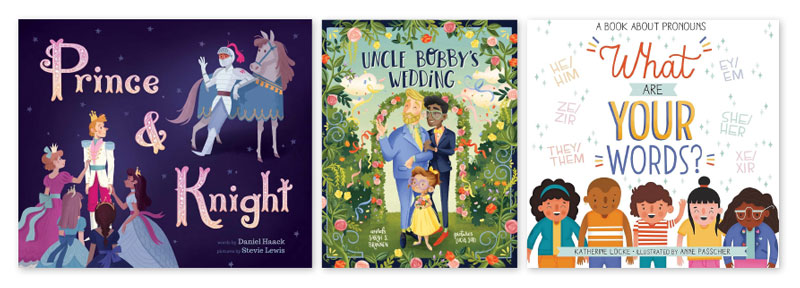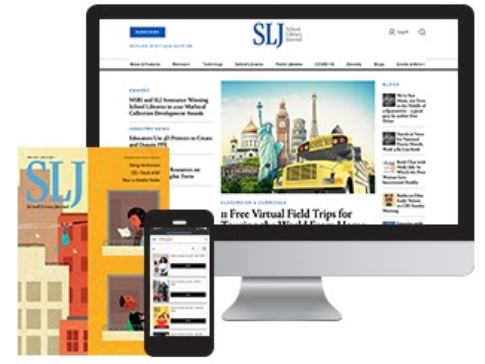SLJ Reviews: Books at the Center of Supreme Court Case
The Supreme Court will hear oral arguments in Mahmoud v. Taylor, a legal dispute that started when a Maryland district added books with LGBTQIA+ characters and themes to its curriculum and did not allow parents to opt out of instruction. Here are SLJ's reviews of those books.
![]()
On Tuesday, April 22, the Supreme Court will hear oral arguments in Mahmoud v. Taylor, a lawsuit brought by parents against the Montgomery County (MD) School District for not allowing their children to opt out of instruction when materials with LGBTQIA+ characters or themes are used.
Amy Howe of Scotusblog explains the case, "A coalition of parents from Montgomery County, Md., contend that requiring their children to participate in instruction that includes LGBTQ+ themes violates their religious beliefs and thus their First Amendment right to freely exercise their religion." Howe continues, "The dispute before the justices on Tuesday began in 2022, when the county approved books featuring LGBTQ+ characters for inclusion in its language-arts curriculum. ... When the county announced in 2023 that it would not allow parents to opt to have their children excused from instruction involving the storybooks, a group of Muslim, Catholic, and Ukrainian Orthodox parents went to federal court. They contended that the refusal to give them the option to opt their children out violated their constitutional right to freely exercise their religion—specifically, their ability to instruct their children on issues of gender and sexuality according to their faith and to control when and how these issues are introduced to their children."
The lower courts ruled against the parents, saying that the plaintiffs had not shown that exposure to the books "compelled them to violate their religion." The Montgomery County board of education, along with its superintendent, Thomas Taylor, who is named in the suit, agree. They add that based on prior Supreme Court cases, the parents must show that their children are being coerced to change their religious belief or practice. At the core of this case is also the practicality of allowing such parental opt-outs with the defendants' brief stating that allowing parents to pick and choose which aspects of the curriculum will be taught to their children would "leave public education in shreds."
The Supreme Court will consider the following question: Do public schools burden parents’ religious exercise when they compel elementary school children to participate in instruction on gender and sexuality against their parents’ religious convictions and without notice or opportunity to opt out?
At the core of the complaint is a group of books, but which books are a point of contention, as the briefs from the plaintiffs and the defendants don't contain the same lists. The plaintiffs list seven titles in their complaint: Pride Puppy by Robin Stevenson; My Rainbow by Deshanna Neal and Trinity Neal; Intersection Allies: We Make Room for All by Chelsea Johnson; Love, Violet by Charlotte Sullivan Wild; Born Ready: The True Story of a Boy Named Penelope by Jodi Patterson; and Jacob's Room to Choose by Sarah Hoffman and Ian Hoffman. The district's brief notes five books at issue: Uncle Bobby's Wedding by Sarah Brannen; Prince & Knight by Daniel Haack; Love, Violet; Intersection Allies; and Born Ready. Three titles appear on both lists.
Below are the SLJ reviews available, alphabetically by title, for all of the books mentioned in the case.

Born Ready: The True Story of a Boy Named Penelope by Jodie Patterson. illus. by Charnelle Pinkney Barlow. Crown. 2021. ISBN 9780593123638.
K-Gr 3–Readers will cheer for karate-loving Penelope, Patterson’s real son, whose experiences as a Black transgender child are heartwarming and inspirational. His story begins with significant annoyance as he just wants his family to hear and see his struggles with identity. However, when his parents finally listen and lovingly embrace his true gender, so does his grandfather all the way from Ghana as well as his principal at school. This offers powerful guidance for caregivers who may be new to gender expression or transgender identities. Penelope is an inspiration to all children, regardless of gender.–Kerra Mazzariello
IntersectionAllies: We Make Room for All by Chelsea Johnson & others. illus. by Ashley Seil Smith. Dottir. 2019. ISBN 9781948340083.
PreS-Gr 4–A cheerful, diverse cast of friends describes living the ally life in this progressive picture book. Told in simple rhyming text, the book shares the stories of each child in the group. Though they’re all the same age, the friends are otherwise very different. Allie uses a wheelchair; her friends make sure she is included in all their games. Kate identifies as nonbinary; her friends make sure she feels safe in all spaces, including school bathrooms. Adilah wears her hijab proudly; her friends love and support her religious expression. Nia’s family marches in a Black Lives Matter protest; all her friends join in solidarity. The Dakota Access Pipeline protests are also highlighted by Dakota and her tribe. Immigrant stories are included as well, with Gloria, Heejung, and Yuri sharing their experiences and receiving loving encouragement from their friends. Their unwavering support for one another helps readers understand what intersectionality means and looks like. The bright, sweet illustrations have a charming silk-screen look that perfectly complements the heartfelt snapshots of the kids. A foreword, an afterword, book notes, discussion questions, and a letter to adults thoughtfully elevate this rhyming story of solidarity.–Abby Bussen
Jacob’s Room to Choose by Sarah Hoffman & Ian Hoffman. illus. by Chris Case. 2019. ISBN 9781433830730.
PreS-Gr 2–In this follow-up to Jacob’s New Dress, Jacob and Sophie try to use the bathroom at school but do not feel safe. Jacob, a boy who wears dresses, is threatened by several kids in the boy’s restroom, while Sophie, a girl who dresses in a plaid button-down and khakis, is chased out of the girls’ restroom. When they explain what happened to their teacher, the woman gathers their class for a lesson: not everyone looks like the bathroom signs for girls and boys, but everyone has to pee! The class takes a little time to consider, but is ultimately inspired. As a group, they make signs affirming everyone’s right to use the bathroom without fear. There is no opposition from the school or parents—everyone is completely supportive. An author’s note explains the importance of making bathrooms safe for gender nonconforming youth. Case’s bright watercolor illustrations show a diverse and engaged classroom, and reinforce the emotional journey of the text. The text, though simple, clearly makes the case for making bathrooms safe for everyone, modeling a simple discussion on the topic for teachers or parents.–Kelsey Socha

Love, Violet by Charlotte Sullivan Wild. illus. by Charlene Chua. Farrar. 2022. ISBN 9780374313722.
PreS-Gr 2–In this sensitive picture book about first friendship and first crushes, Violet, who has pale skin and red hair, daydreams about taking her friend Mira, who has light brown skin and curly hair, on heroic adventures. “As far as Violet was concerned, only one person in her class raced like the wind. Only one had a leaping laugh. Only one made Violet’s heart skip.” But every time Violet tries to tell Mira how she feels, she goes shy. As Valentine’s Day approaches, Violet decides that a handmade card is the perfect way to show Mira just how special she is. A soothing color palette enhances the story’s quiet and lighthearted tone, and transparent watercolor washes on textured paper add light and warmth to wintry scenes. Children will notice Mira’s baffled expressions in the background as Violet frets, offering opportunities for conversation around social-emotional learning. Cheerful schoolmates are drawn with varying shades of skin and hair types. Mira’s warm response when Violet finally delivers her valentine is touching and sends a reassuring message about being true to one’s feelings. While the girls’ relationship is not explicitly romantic, Violet’s daydreams (where, for example, she is wearing a knight’s outfit and laying treasure at Mira’s feet) and her skipping heart suggest that her feelings may grow into something more.–Amy Fellows
My Rainbow by Deshanna Neal & Trinity Neal. illus. by Art Twink. Penguin/Kokila. 2020. ISBN 9781984814609.
PreS-Gr 2–A lively #OwnVoices picture book tribute to a family’s unwavering support of their transgender daughter, written by a mother-daughter advocate duo and based on their experiences. Trinity, who is a Black transgender girl, liked to play with her siblings, her dolls, and her pet pig, Peter Porker. One day, Trinity expressed frustration that she couldn’t be a girl because she didn’t have long hair. She needed long hair to feel like herself. When Trinity’s mother pointed out her own short hair, Trinity explained, “People don’t care if cisgender girls like you have short hair. But it’s different for transgender girls. I need long hair!” The family took a trip to the beauty store. None of the wigs seemed to be the best choice for Trinity. Mom took matters into her own hands and crafted a one-of-a-kind rainbow wig just for her daughter. Trinity loved it: “It’s me, Mom. My hair has finally come!” The text’s frank and refreshing usage of terms such as cisgender will spark necessary conversations between children and caregivers. Twink’s digital illustrations are vibrant and colorful, just like Trinity and feature small but important details, including a beauty store employee named Maya wearing a “they/them” pronoun name tag. Some readers may feel that a few details could have been expanded on, such as Trinity’s autism, which is acknowledged throughout the book but is not the main focus.–Allison Staley
Pride Puppy! by Robin Stevenson. illus. by Julie McLaughlin. Orca. 2021. ISBN 9781459824843.
PreS-Gr 2–This colorful alphabet story begins with a family waking up, preparing for the day, and dressing in their Pride best: head to toe in rainbow colors! As the alphabet advances, each letter represents everything from intersectional flags to a “queen in a beautiful dress” as a joyful parade glides through town. Paradegoers gleefully display signs with messages of gender equality, peace, love, and respect. At the center of each vibrant illustration, is, of course, a very happy puppy proudly wearing its pride scarf. Children of all ages will love reading this with family members as all different abilities, body types, cultures, and ages are represented in this modern and inclusive picture book.–Kerra Mazzariello

Prince & Knight by Daniel Haack. illus. by Stevie Lewis. little bee. 2018. ISBN 9781499805529.
K-Gr 2—Haack and Lewis have created a fairy tale in rhyme about a prince who is looking for a partner. The king and queen help their son meet many young ladies in the kingdom, but he is not interested in any of them. After much deliberation, he decides to leave the kingdom to consider his future. While he is gone, a dragon threatens the royal family and villagers. The prince and knight vanquish the dragon and realize they are perfect for one another. The king and queen are so happy their son has found true love. The digital illustrations are rich in color and depth. This is an illuminating fairy tale for young readers to be able to see that not every prince would like to marry a princess.–April Sanders
Uncle Bobby’s Wedding by Sarah Brannen. illus. by Lucia Soto. little bee. 2020. ISBN 9781499810080.
What Are Your Words?: A Book About Pronouns by Katherine Locke. illus. by Anne Passchier. Little, Brown. 2021. ISBN 9780316542067.
PreS-Gr 3–Ari’s Uncle Lior comes to visit, and the pair walks through town to a neighborhood summer bash. Uncle Lior uses they/them pronouns, and they make a habit of always asking Ari, “What are your words?” Sometimes Ari knows which pronouns feel just right, but on this day, it’s tricky to decide. On the way to the bash, Ari introduces Uncle Lior to everyone in town using that person’s pronouns, which are illustrated over their head, along with a few words describing their personality. Ari’s family is light brown-skinned, and their neighbors represent a range of skin tones, abilities, and genders. After the bash, Ari invites the reader to share their own words and pronouns after finally settling on they/them pronouns for the day. Passchier’s colorful, geometric digital illustrations match the joyful tone of the text, bringing the whole neighborhood to life. Pronouns from around the world decorate the end papers.–Allison Staley
RELATED
The job outlook in 2030: Librarians will be in demand
The job outlook in 2030: Librarians will be in demand
ALREADY A SUBSCRIBER? LOG IN
We are currently offering this content for free. Sign up now to activate your personal profile, where you can save articles for future viewing






Add Comment :-
Be the first reader to comment.
Comment Policy:
Comment should not be empty !!!